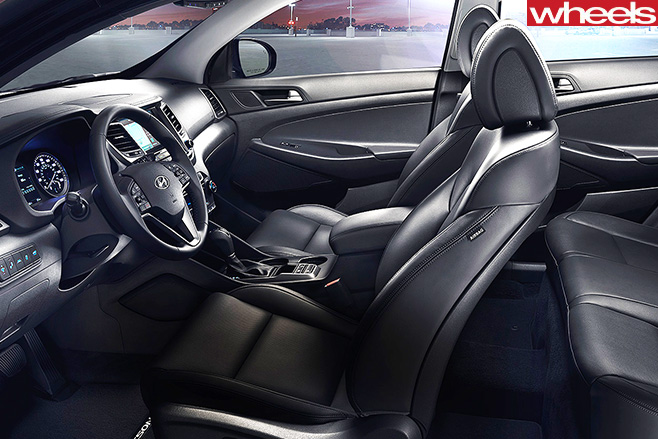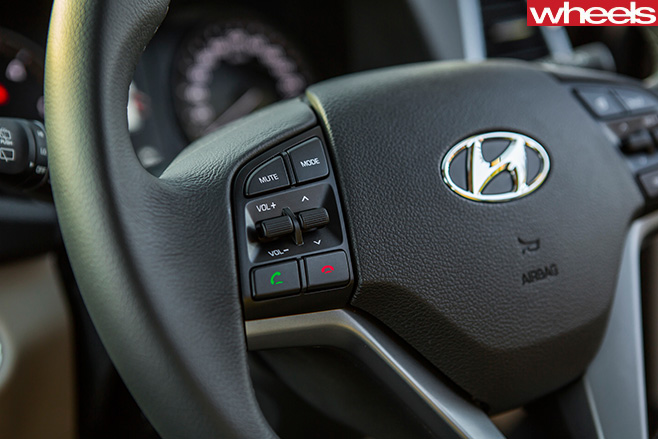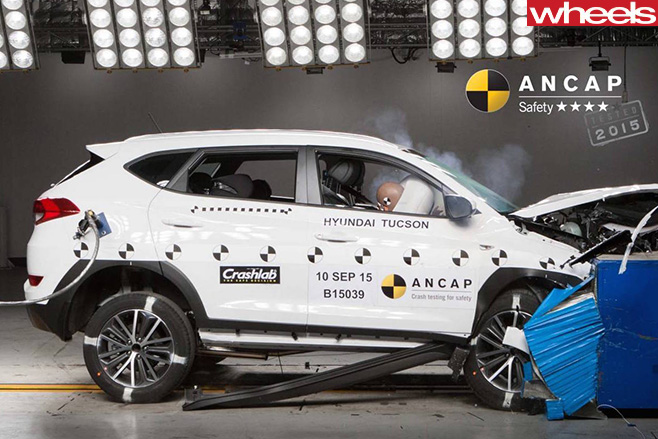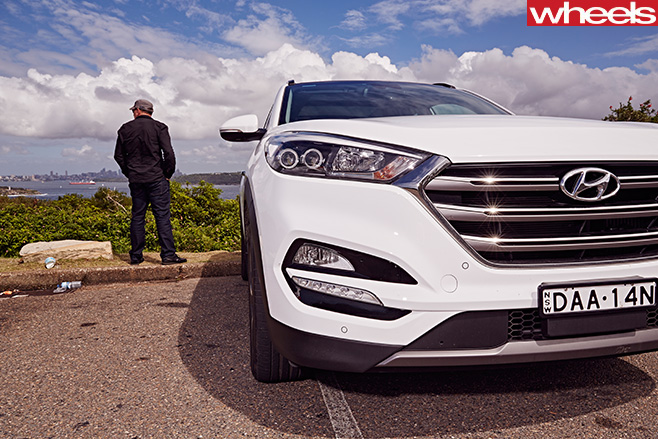Ponch’s long-term Mercedes-AMG C63 S needed a home for a few weeks and I couldn’t resist the lure of its almost satanic twin-turbo V8.
The first few days passed in a frenzy of monster torque locked in brutal battle with sticky Michelins, and just a little spinal tap courtesy of the ultra-firm ride. Which is to say everything was going perfectly, right up until the power steering failed. Have you ever tried to extract yourself from an underground car park on 245/45 front tyres with unassisted steering? Wrestling a polar bear would be less strenuous.
I nursed the C63 to the local Benz dealership and, sweatier than James Brown’s jock strap, collapsed into the cool embrace of the Hyundai Tucson. And I’ve gotta say the transition was entirely painless. I love a good super-sedan as much as the next power junkie, but there’s something about driving an angry 700Nm German sledgehammer around my neighbourhood that makes me think of shooting ducks with a grenade launcher.
The Tucson, on the other hand, is a study in practical, affordable, family friendly motoring. And a damn handsome one. The crisp lines, short overhangs and sharply tapered glasshouse make this, I’d argue, Hyundai’s best-looking car. It’s far more masculine than the slightly androgynous Hyundai ix35 it replaces, without being excessively boofy or cartoonish.

The Highlander diesel is the most expensive Tucson model in the range, offered only with a six-speed torque-convertor auto. Our paint is a basic white, not a metallic that would have added $595, which exhausts the options list in one fell box-tick.
Opting for the turbo-petrol 1.6 Highlander with seven-speed dual-clutch would have saved $2000, or you can stick with the diesel and pocket more than $5K by dropping one spec level to the Elite CRDi at $40,240.
I’m glad that’s not a choice we had to make because the extra gear the Highlander brings is nice to have. Both front seats are fully electric in their adjustment, and have both heating and cooling functions. I’m finding the three-position cooling fan especially welcome, particularly if, for example, you’ve worked up a sweat trying to manoeuvre a Mercedes-AMG with no power steering.
The glass roof makes the rear-seat accommodation feel extra light and spacious, while the electric tailgate with its hands-free operation (you just stand behind it for three seconds with the key in your pocket) is a brilliant feature I’d hate to be without.

The touchscreen’s graphics feel a bit dated, but its functionality, and that of the navigation, is excellent.
The only other let-down is the slightly dour and non-premium interior materials. There’s too much hard plastic, slabby door-trims and unlined storage bins for a top-spec model. It’s a shame because I can’t fault the ergonomics, and we know Hyundai can do materials and finishes better than this.
It’s in the driving, though, that the Tucson hammers home just how far the Koreans have progressed in recent years, and the dynamic dividends that have come from local suspension and steering development. The Tucson may not be quite class-leading, as our SUV comparison review in the November issue proved, but it’s so close as to not really be a factor in general driving. The bottom line is it steers fluently, rides with real compliance (even on the 19s) and has good body control and damping, despite being on the heavy side at 1744kg.
Ponch’s AMG may have the shock-and-awe elements sewn up, and the power steering failure was quickly sorted. But so far the Tucson’s great blend of functionality, spaciousness and coherent driving qualities has put me in a place where shock and awe aren’t crucial to satisfaction.
Hitting the wall

Update #2
BACK in high school, we had the classic PE teacher straight from central casting. Quads like wine barrels, a head like an Easter Island statue, and a top lip crowned with a belter of an ’80s pornstar moustache (well, to be fair, it was the ’80s, and what he did in his spare time was his own business).
He also had a sadistic love of inflicting pain on pimply teenagers. Prized among his cache of suffer-fest activities was the dreaded Tuesday morning shuttle-run session. It took the normally semi-enjoyable activity of running, but stripped it of any rhythm, flow or changing scenery. Instead, by making it a series of stop-start bursts between marker cones, it turned running into something that made us mostly turn purple and want to puke.
I’ve been inflicting the automotive equivalent of shuttle runs on the Hyundai Tucson this month, but rather than turning purple and puking on me, payback is being delivered by consumption in the mid-12s. For those of you playing along at home, its official urban number is 8.9L/100km.

Our SUV comparo last November, over a typically wide variety of driving conditions, saw the Tucson Highlander in 1.6-litre turbo-petrol spec come second to the Mazda CX-5 for economy at 10.9L/100km. The turbo-petrol Highlander may not have the grunt of my diesel (265Nm at 1500-4500rpm against the oiler’s 400Nm at 1750-2750rpm) but it’s appreciably quieter at idle and under initial load, and of course it’s more eager and enjoyable in its upper reaches. It’s also $2000 cheaper than the diesel.
I’m on the fence with this one, as I do like the diesel’s unstressed urban response and the mapping of the torque-converter auto to deliver swift short-shifts to keep the revs down on a light throttle.
If you are considering a Tucson – or pretty much any vehicle where you need to decide between diesel and petrol – I’d urge you test drive both, and think hard about what sort of conditions will make up the bulk of your driving. And, of course, treat the official consumption numbers with the same scorn and scepticism as a politician’s promise.
Update #3
MY PARTNER and I were a few kays from the Jenolan Caves in the Hyundai Tucson recently, enjoying a weekend out of Sydney. She was singing along chirpily to a sexy Brazilian songstress I now know to be called Ivete Sangalo, while I was cheerfully spanking the Hyundai on some empty sweeping roads.
It was getting late in the afternoon and we were headed in the general direction of home when I braked hard and swung left onto an unsignposted dirt road.
“Where does this road go?” she asked. “No idea, baby”, I replied. “Then why have we turned onto it?” she responded, reasonably. “Because it’s dirt, baby,” I explained, helpfully. “Is that a good thing?” she asked.
Where she’s from, many of the roads are still dirt, and that’s often Not A Good Thing. The wrong dirt road can lead to a carjacking, robbery, and maybe a bit of cheerful kidnapping action. But I explained that here in the land Down Under, driving on dirt roads was a great thing, “because we’re in an Esse You Vee, baby!”
Yes, the pragmatist in me knows I don’t need an SUV; I have no real need for its light-duty off-road ability or its torque-splitting cleverness. A good old rear-drive wagon would do me just fine. Probably because of this I feel compelled to explore any snotty little bit of backcountry I spot, purely because, well, I’m in an SUV, baby, and I can.

I looked in vain for a side trail that would have provided a snotty plunge worthy of the hill-descent control. Sadly no such luck, so that feature’s usefulness remains elusive.
The dirt road ended at a trail that led to a spectacular lookout, with vast, sweeping views of the towering escarpments of the Blue Mountains, so I did revel in a little go-anywhere SUV smugness as I held my girlfriend’s hand while we soaked in the glorious vista.
Then, on the way back, we rounded a sweeping slippery section to see an old Ford EB Falcon wagon, probably on knackered retreads, coming towards us. It was cocked slightly sideways, being held in deft control by a 20-something bloke with his mate, doing what Aussies have done on dirt and in rear-drive wagons for decades, long before the rise of the SUV.
There’s a message in there somewhere.
Update #4
Sometimes you wish your car could go holiday with you.
AS A motoring writer you get asked, endlessly, “So, what’s the best car you’ve ever driven?” I’m okay with it, but I do wish someone would ask me about the worst. That would be easier. I could simply answer: “The one I just spent three weeks driving through Italy – a Mini Cooper One D.”
I would then bore my new acquaintance rigid with details of the abhorrent, crashy ride, the inexplicable lack of front-to-rear handling cohesion, and the deafening tyre and suspension noise. I could finish by turning purple with rage and indignation, chest-poking, and shouting, “Who signed off on this little munter? WHO, goddammit?!”
Okay, so it’s probably best you don’t ask me the worst-car question. And perhaps ‘worst’ is a bit harsh. But most deeply disappointing, definitely.
If nothing else, though, the experience of 3500km in the Mini did give me a renewed appreciation of my long-term Tucson. God, I missed it. I may have mentioned this to my long-suffering partner, but only three or four hundred times.
Yes, of course I know these two cars are not comparable in a conventional sense. But consider the underlying design and engineering fundamentals and you quickly gain an insight into how things get done right, and where things go so wrong.
The Hyundai Tucson may be low-ish on glitz and interior seduction, but it pretty much nails the fundamentals, especially with its localised ride and handling program. Anyone can jump in, drive it over virtually any surface, and feel confident and comfortable.
Visibility is excellent, the controls are intuitive, the gauges and displays legible and logical. Everyone sits comfortably, has space to store stuff, and in terms of meeting its intended function, there’s nothing at which to point and go, “That’s awful”.
The Mini, in stark contrast, feels like a concerted exercise in putting questionable form over fundamental function. It really irks me that time and money has been thrown at dumb gimmicks while the basics feel to have been overlooked.
Fortunately Italy’s many charms were enough to lift my spirits each time I got out of the Mini, but there was rarely a moment when I didn’t miss the Tucson’s fundamental rightness, on everything from high-speed autostradas to postcard-perfect backroads. Its planted stance and absorbent ride would have lapped up stuff that sent the Mini into a major-league tizz.
I’d also tender as evidence my upper right arm, having foolishly given my partner permission to punch me anytime I uttered, “Honey, I really miss the Tucson”.
The deep purple bruising has only just started to fade.
Farewell
EAVESDROP on a typical pub conversation, especially around election time, and it’s clear just how easy it must be to do someone else’s job. Running the country? Pah, nothin’ to it; just ask any schooner-swilling scholar of the Westminster system.
I figured the same may be true for automotive product planning and model development. I have zero experience working for a car company so I’ve no idea of the constraints that these people must work within. Therefore, of course, I could do their job. I’m probably overqualified.
So as the Hyundai Tucson leaves the Wheels garage, and I reflect on the largely positive ownership experience over the last six months, I thought I’d offer some friendly product-planning advice to Hyundai regarding what could be improved with the facelift.
My first missive would be to tell the styling department to put down the crayons and step away from the clay model. The exterior design is excellent and there’s no reason to waste money messing with it. Okay, consider upgrading the rear lights to LEDs, and maybe a discreet Series II badge, but that’s it. I’d say buck conventional wisdom; bin the plans for new bumpers and wheel designs, and spend the money on things customers are actually going to appreciate, like an interior upgrade and plumping up the standard equipment.
Let’s start with trim. The hard dash plastics and budget-looking door-trims need to go. Let’s have some more premium materials, extra padding, nice detail stitching and some flashes of aluminium instead. Line the doorbins to stop stuff rattling (hell, VW manage it in a base-model Golf). And add a proper pair of matching LED lights for the cargo compartment, not the existing dim little bulb that’s less bright than Bob Katter after a B&S ball.
While we’re back there in the cargo compartment, can I suggest adding remote releases for the rear seats? That’s the logical place for them, not on either side of the seats themselves, which make you move from one side of the car to the other just to prepare for a load.
Now, let’s sort the infotainment. Get someone to spend time in a top-spec Subaru Forester XT Premium and listen to its Harman Kardon sound system; that’s the benchmark for this class. Highlander needs a decent centre channel, a subwoofer and a serious amplification upgrade. And better speakers all round, especially in the back, where they sound like they were pulled out of a Taiwanese telephone. A DAB radio tuner is also surely mandatory for Highlander spec. And how about lobbing in a head-up display? The cheapest car in Oz with this feature is the Mazda 2 Genki, so cost excuses are running thin.
Keep the steering wheel; it’s sized right and the audio and cruise controls fall perfectly to each thumb, but could it be trimmed in something a little more tactile, please, rather than vinyl?
Now let’s whip up a job sheet for the engineering team. Top of the list: more NVH suppression for the diesel. I know it’s not bad, but it’s still way louder and more vibey than the Tucson turbo-petrol, and competitors like the CX-5 have closed this gap by a much greater margin. So consider addressing clatter, improving the engine mounts, and adding more firewall and under-bonnet sound-deadening.
Finally, the steering; a clear case of ‘reasonable, but could do better’. For my taste it’s a bit springy either side of centre, and at 2.7 turns it could be a little quicker. It would be ideal if it was benchmarked against the Ford Kuga and delivered that lovely, slick, well-damped yet responsive feel.
Okay, I suspect that some of these suggestions may be a case of easier said than done (hey, I’m an imposter, not a realist), but even if only some made it to the updated model, Tucson would make the step from excellent to outstanding.






